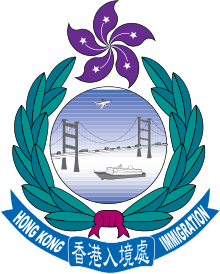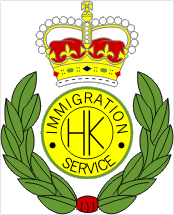Immigration Department (Hong Kong)
| 入境事務處 | |
 | |
| Agency overview | |
|---|---|
| Formed | 4 August 1961[1] |
| Jurisdiction | Hong Kong |
| Headquarters | 7 Gloucester Road, Wan Chai |
| Employees | 6,569 |
| Minister responsible | |
| Agency executive |
|
| Website | Official website |
The Immigration Department (Chinese: 入境事務處, known as 人民入境事務處 before the 1997 transfer of sovereignty) of the Government of Hong Kong is responsible for immigration control of Hong Kong. After the People's Republic of China assumed sovereignty of the territory in July 1997, Hong Kong's immigration system remained largely unchanged from its British predecessor model. Residents from mainland China do not have the right of abode in Hong Kong, nor can they enter the territory freely, both before and after 1997. There are different regulations that apply to residents of Macau, another Special Administrative Region of China. In addition, visa-free entry acceptance regulations into Hong Kong for passport holders of some 170 countries remain unchanged before and after 1997.
In a special arrangement, although Hong Kong's residents of Chinese descent are defined as citizens of the People's Republic of China, as stipulated by the Basic Law, Hong Kong's Immigration Department is independently responsible for issuing Hong Kong SAR passports for Hong Kong residents who are also PRC citizens seeking international travel.
History


Prior to the 1950s, immigration to Hong Kong was not controlled by the government of Hong Kong and migrants freely entered Hong Kong. But the end of World War II the influx of migrants from China to Hong Kong to flee Communist rule resulted in immigration control.
From 1949 to 1961, registration of persons with identification was required under the Registration of Persons Ordinance 1949 and established a Commissioner of Registration.
Until the establishment of Immigration Department on 4 August 1961, immigration control in Hong Kong was handled by the Hong Kong Police Force.[3] The Immigration Service Ordinance 1961 created the new department in charge of immigration control. Later in 1977, the department enlarged its functions to cover registration of persons by amalgamating with the Registration of Persons Office and Director of Immigration also assumed as Commissioner of Registration.[4] In 1979, the department took over from the Registrar General civil registration duties and the Director of Immigration was appointed as Registrar of Births and Deaths, and Registrar of Marriages.
Role

Apart from immigration control, the Department has a Registration of Persons division and a Births, Births, Deaths and Marriage Sub-division where Hong Kong residents go to obtain Hong Kong Identity Card and register births, deaths and marriages.
Until 1997, the Department was the British passport-issuing authority in Hong Kong until the end of British rule. The passport mostly issued were for British Dependent Territories citizen and not a full British one. By the late 1990s the British National (Overseas) passport was also issued by the Department. Since 1 July 1997, the British Consulate-General in Hong Kong has performed this role, mainly for renewal or replacement of BN(O) passports.
Under the terms of the Basic Law of Hong Kong and explanations on implementing the Nationality Law, both by PRC lawmakers, the Immigration Department issues the Hong Kong Special Administrative Region passport and other international travel documents on its own, and is in charge of administering the Nationality Law within its realms. This is a rare exception to the rule that issuing passports and administering nationality-related matters are usually under the purview of an authority of the central/national government of a state.
The Department also issues travel documents, such as the Document of Identity and Hong Kong Re-entry Permit, to Hong Kong residents who cannot obtain a passport.[5]
The Department is headquartered in the Immigration Tower in Wan Chai North.
Directors of the Immigration Department (Since 1 July 1997)
- Erick Tsang Kwok-wai (2016-present)
- Eric Chan Kwok-ki, IDSM (2011-2016)
- Simon Peh, IDSM (2008–2011)
- Lai Tung Kwok, IDSM (2002–2008)
- Ambrose Lee, IDSM (1998 to 2002)
- Regina Ip (July 1997 to 1998)
British National (Overseas)
The Immigration Department was responsible for BN(O) passport applications and data prior to 1 July 1997. Prior to the handover, all information was transferred to the British Consulate-General, Hong Kong.
Inquiries in regards to BN(O)s are now made to any British diplomatic missions overseas.
See also
Ranks
As with all of the HK Disciplined Services, British-pattern ranks and insignia continue to be utilised, the only change being the exchange of the St. Edward's Crown for the Bauhinia Flower crest post-1997.
- Director of Immigration (similar insignia to a UK General)
- Deputy Director of Immigration (similar insignia to a UK Lieutenant-General)
- Assistant Director of Immigration (similar insignia to a UK Major-General)
- Senior Principal Immigration Officer (similar insignia to a UK Colonel)
- Principal Immigration Officer (similar insignia to a UK Lieutenant-Colonel)
- Assistant Principal Immigration Officer (similar insignia to a UK Major)
- Chief Immigration Officer (similar insignia to a UK Captain)
- Senior Immigration Officer (similar insignia to a UK Lieutenant with a silver bar beneath)
- Immigration Officer (similar insignia to a UK Lieutenant)
- Immigration Officer (Probationary) (similar insignia to a UK Second Lieutenant) (with effect from 19 April 2010)
- Assistant Immigration Officer (similar insignia to a UK Second Lieutenant) (rank discontinued in November 1998)
- Chief Immigration Assistant (three silver bars)
- Senior Immigration Assistant (two silver bars)
- Immigration Assistant (silver bar)[6]
Crest
The current crest of the force was adopted in 1997 to replace most of the colonial symbols:
- St Edward's Crown replace with Bauhinia
- Laurel wreath remains but badge with wording Immigration Service – HK" replace with an image of Tsing Ma Bridge is added
- Motto added with wording "Hong Kong Immigration 香港入境處"
Source: Immigration Department (Hong Kong)
Weapons
Instead of the Smith & Wesson Model 10 revolver widely distributed between disciplinary services in Hong Kong, the officers are trained in the use of, and issued, the ASP expandable baton and the Sabre Red pepper spray for self-defence options.
A type of pepper gun is also standard issue equipment for officers stationed at the Immigration Service Institute of Training and Development, due to one incident of arson at the Immigration Tower in 2000.
References
Order of precedence
| Preceded by Customs and Excise Department (Hong Kong) |
Immigration Department (Hong Kong) | Succeeded by |
External links
| Wikimedia Commons has media related to Immigration Department (Hong Kong). |
